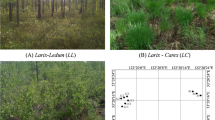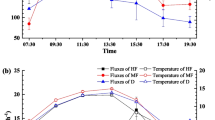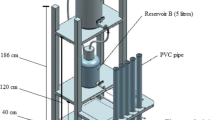Abstract
Freezing-thawing in mid-high latitudes is an important factor controlling nutrient dynamics. We transplanted peatland columns (TQ) and freshwater marsh columns (SJ) in different latitudes into south seasonal frozen regions to determine the responses of greenhouse gas emissions from different wetlands to the freezing-thawing under climate warming. The decrease in CO2 and CH4 emissions during freezing stage were interrupted by a short emission peak. While N2O uptake rate reduced with decreasing temperature. In the thawing stage, all the three greenhouse gases exhibited emission peaks. CO2 were 159.83 mg m−2 h−1 (TQ) and 86.83 mg m−2 h−1 (SJ); CH4 were 1.32 mg m−2 h−1 (TQ) and 4.07 mg m−2 h−1 (SJ); N2O were 72.14 ug m−2 h−1 (TQ) and 22.15 ug m−2 h−1 (SJ). Meanwhile, N2O transferred from sink into source. With temperature increase, the emission rate of CO2 increased fast, while CH4 and N2O decreased. CO2 emission during freezing-thawing periods was significantly correlated with soil temperature and CH4 emission. Soil active organic carbon also played important roles in greenhouse gases emissions. Our study suggested that more greenhouse gases may release from wetlands into atmosphere in the context of global warming, and the potential release of CO2 and N2O during freezing-thawing periods was much higher in peatlands of permafrost zone.





Similar content being viewed by others
References
Bouwman AF (1994) Direct emissions of nitrous oxide from agriculture soil. Report No. 773994004, National Institute of Public Health and Environmental Protection, Bilthoven, Netherlands
Bubier J, Crill P, Mosedale A (2002) Net ecosystem CO2 exchange measured by autochambers during the snow-covered season at a temperate peatland. Hydrological Processes 16:3667–3682
Burton DL, Beauchamp EG (1994) Profile nitrous oxide and carbon dioxide in a soil subject to freezing. Soil Science Society of America Journal 58:115–122
Cambardella CA, Elliott ET (1992) Particulate soil organic-matter changes across a grassland cultivation sequence. Soil Science Society of America Journal 56:777–783
Feng XJ, Nielsen LL, Simpson MJ (2007) Responses of soil organic matter and microorganisms to freeze-thaw cycles. Soil Biology and Biochemistry 39:2027–2037
Gregorich EG, Ellert BH (1993) Light fraction and macroorganic matter in mineral soils. In: Carter MR (ed) Soil sampling methods and analysis. Canadian Society of Soil Science, Lewis
Grogan P, Michelsen A, Ambus P et al (2004) Freeze–thaw regime effects on carbon and nitrogen dynamics in sub-arctic heath tundra mesocosms. Soil Biology and Biochemistry 36:641–654
Hargreaves KJ, Fowler D, Pitcairn CER, Aurela M (2001) Annual methane emission from Finnish mires estimated from eddy covariance campaign measurements. Theoretical and Applied Climatology 70:203–213
Henry HAL (2007) Soil freeze-thaw cycle experiments: trends, methodological weaknesses and suggested improvements. Soil Biology and Biochemistry 39:977–986
Herrmann A, Witter E (2002) Sources of C and N contributing to the flush in mineralization upon freeze-thaw cycles in soils. Soil Biology and Biochemistry 34:1495–1505
Hershfield DM (1979) Freeze-thaw cycles, potholes, and the winter of 1977–78. Journal of Applied Meteorology 18:1003–1007
Jones DL, Willett VB (2006) Experimental evaluation of methods to quantify dissolved organic nitrogen (DON) and dissolved organic carbon (DOC) in soil. Soil Biology and Biochemistry 38:991–999
Kato T, Hirota M, Tang Y et al (2005) Strong temperature dependence and no moss photosynthesis in winter CO2 flux for a Kobresia meadow on the Qinghai–Tibetan plateau. Soil Biology and Biochemistry 37:1966–1969
Kidd RA, Bartsch A, Wagner W (2004) Development and validation of a diurnal difference indicator for freeze-thaw monitoring in the Siberia П project. Proceedings ENVISAT Symposium, Salzburg
Koponen HT, Martikainen PJ (2004) Soil water content and freezing temperature affect freeze-thaw related N2O production in organic soil. Nutrient Cycling in Agroecosystems 69:213–219
Lafluer PM, Roulet NT, Admiral SW (2001) Annual cycle of CO2 exchange at a bog peatland. Journal of Geophysical Research 106:3071–3081
Liu XT (2005) Wetlands in northeastern China. Science Press, Beijing (in Chinese)
Ludwig B, Wolf I, Teepe R (2004) Contribution of nitrification and denitrification to the emission of N2O in a freeze-thaw event in an agricultural soil. Journal of Plant Nutrition and Soil Science 167:678–684
Ludwig B, Teepe R, Gerenyu VL, Flessa H (2006) CO2 and CH4 emissions from gleyic soils in the Russian tundra and a German forest during freeze-thaw periods-a microcosm study. Soil Biology and Biochemistry 38:3516–3519
Mastepanov M, Sigsgaard C, Dlugokencky EJ et al (2008) Large tundra methane burst during onset of freezing. Nature Letters 456:628–631
Miao YQ, Song CC, Wang XW et al (2012) Greenhouse gas emissions from different wetlands during the snow-covered season in Northeast China. Atmospheric Environment 62:328–335
Mikan CJ, Schimel JP, Doyle AP (2002) Temperature controls of microbial respiration in arctic tundra soils above and below freezing. Soil Biology and Biochemistry 34:1785–1795
Miller RD (1980) Freezing phenomena in soils. In: Hillel D (ed) Applications of soil physics. Academic, San Diego, pp 254–299
Priemé A, Christensen S (2001) Natural perturbations, drying–wetting and freezing–thawing cycles, and the emission of nitrous oxide, carbon dioxide and methane from farmed organic soils. Soil Biology and Biochemistry 33:2083–2091
Schimel JP (1995) Plant transport and methane production as controls on methane flux from arctic wet meadow tundra. Biogeochemistry 28:183–200
Sharma S, Szele Z, Schilling R, Munch JC, Schloter M (2006) Influence of freeze-thaw stress on the structure and function of microbial communities and denitrifying populations in soil. Applied and Environmental Microbiology 72:2148–2154
Song CC, Yan BX, Wang YS et al (2003) Fluxes of carbon dioxide and methane from swamp and impact factors in Sanjiang Plain, China. Chinese Science Bulletin 48:2749–2753
Song CC, Wang YS, Wang YY, Zhao ZC (2006) Emission of CO2, CH4 and N2O from freshwater marsh during freeze-thaw period in Northeast of China. Atmospheric Environment 40:6879–6885
Teepe R, Brumme R, Beese F (2000) Nitrous oxide emissions from frozen soils under agricultural, fallow and forest land. Soil Biology and Biochemistry 32:1807–1810
Teepe R, Brumme R, Beese F (2001) Nitrous oxide emissions from soil during freezing and thawing periods. Soil Biology and Biochemistry 33:1269–1275
Vance ED, Brookes PC, Jenkinson DS (1987) An extraction method for measuring soil microbial biomass C. Soil Biology and Biochemistry 19:703–707
Wagner D, Lipski A, Embacher A, Gattinger A (2005) Methane fluxes in permafrost habitats of the Lena Delta: effects of microbial community structure and organic matter quality. Environmental Microbiology 7:1582–1592
Wang LF, Cai ZC, Yang LF et al (2005) Effect of disturbance and glucose addition on nitrous oxide and carbon dioxide emissions from a paddy soil. Soil and Tillage Research 82:185–194
Wang F, Gao SB, Zhang KQ, Yang P, Bai LJ, Huang ZP (2009) Progress on N2O emission from soil in the freeze-thaw process. Ecology and Environmental Sciences 18:1933–1937 (in Chinese)
Wang XW, Li XZ, Hu YM et al (2010) Potential carbon mineralization of permafrost peatlands in Great Hing’an Mountains, China. Wetlands 30:747–756
Wang JY, Song CC, Wang XW, Wang LL (2011) Progress in the study of effect of freeze-thaw processes on the organic carbon pool and microorganisms in soils. Journal of Glaciology and Geocryology 33:442–452 (in Chinese)
Wickland KP, Striegl RG, Mast MA et al (2001) Carbon gas exchange at a southern Rocky Mountain wetland, 1996 1998. Global Biogeochemical Cycles 15:321–335
Zhang ZY (2000) Development and utilization of peat resources. Chinese Jilin Science and Technology Press, Changchun (in Chinese)
Acknowledgments
We gratefully acknowledge the “Strategic Priority Research Program—Climate Change: Carbon Budget and Related Issue” of the Chinese Academy of Sciences (Nos. XDA05050508 and XDA05020501), National Natural Science Foundation of China (Nos. 40930527, 41125001), CAS/SAFEA International Partnership Program for Creative Research Teams, and National Basic Research Program (973) of China (No.2009CB421103) for financial support. We thank Dr. Xianwei Wang and Rong Mao for soil sample collection.
Author information
Authors and Affiliations
Corresponding author
Rights and permissions
About this article
Cite this article
Wang, J., Song, C., Miao, Y. et al. Greenhouse Gas Emissions from Southward Transplanted Wetlands During Freezing-Thawing Periods in Northeast China. Wetlands 33, 1075–1081 (2013). https://doi.org/10.1007/s13157-013-0463-4
Received:
Accepted:
Published:
Issue Date:
DOI: https://doi.org/10.1007/s13157-013-0463-4




